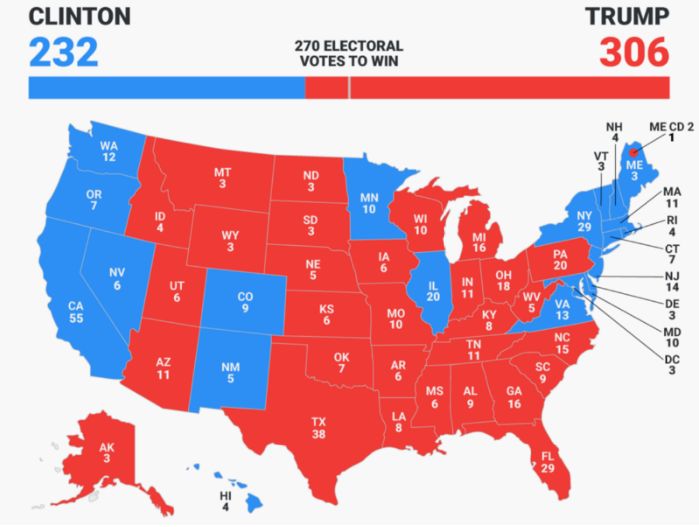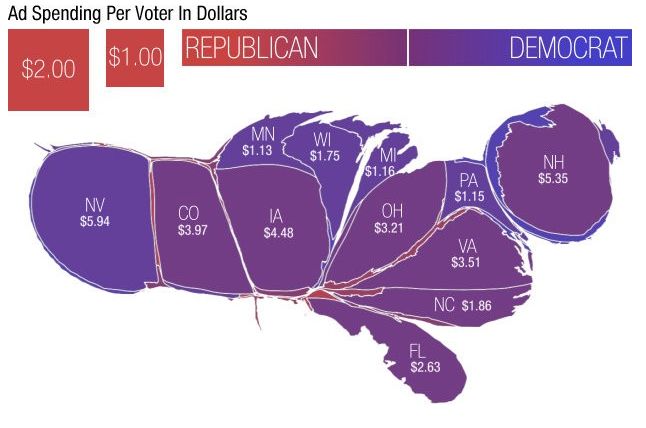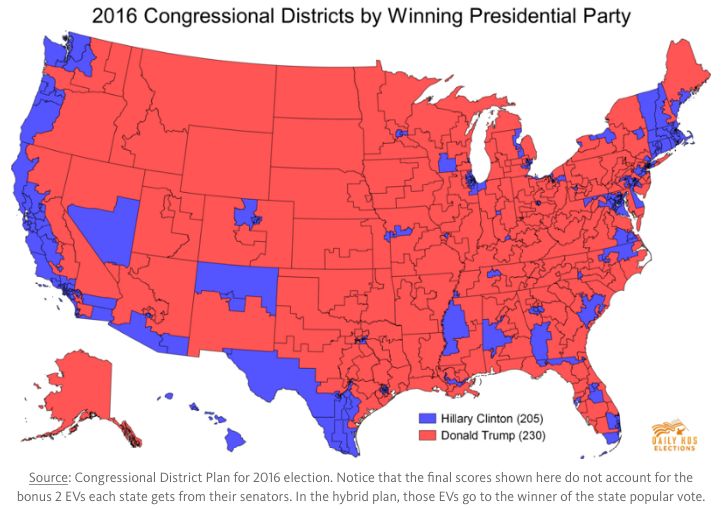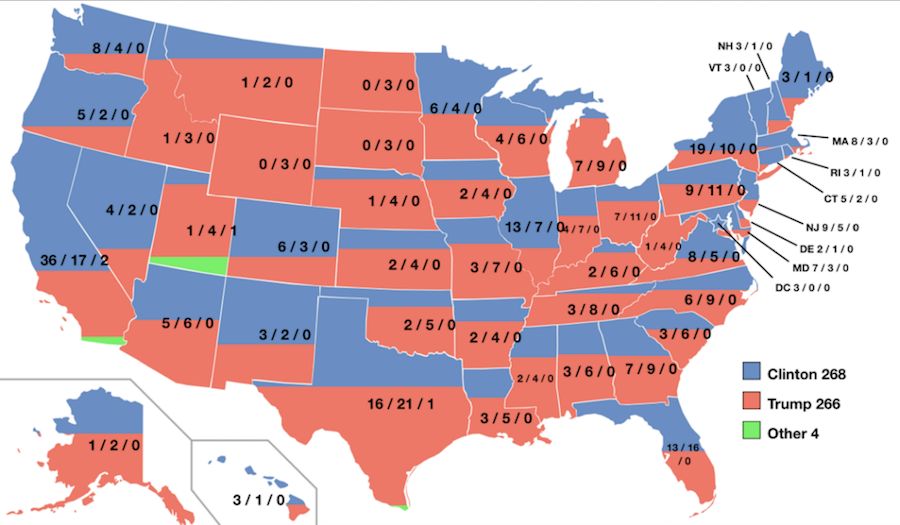Fixing America’s Presidential Elections in Just Two Steps (Part 2)

Recording Votes: Fixing the Electoral College
Our Electoral College (EC) is out of date. Powerful coalitions exist to push for its effective abolishment and a switch to a popular vote, but the support for this movement is not as strong as proponents had hoped. Constitutionally speaking, it will be easier to update the EC and improve it. In this section, I discuss three proposed methods for use of the EC: Winner-Take-All, District Plan, and Proportional Plan.
Winner-Take-All method for the Electoral College
Used by 48 states today, the Winner-Take-All (WTA) method is probably what you think of when you hear “Electoral College”. The way it works is the statewide popular vote winner gets all the Electoral Votes (EVs) from that state. Even if the vote is split 51%-49%, the candidate with 51% gets 100% of the EVs. The WTA method has been praised for creating clear victors with large margins of difference between candidates, which improves the credibility of the winner.

Under Article II, Section 1 of the Constitution, states are given the power to decide how to allocate their electors. Since the birth of the EC, states slowly moved towards the WTA plan because it gives their state more influence. If you are a primarily liberal state, your state legislature will also want the federal government to be liberal, so you adopt a plan that ensures all of your EVs go to the liberal candidate, therefore shutting out any dissenting Republican minority voices in the state. Of course, if one state has this method, all the other states will want it as well, resulting in the system we have today.
The embrace of the WTA EC has created two different categories of problematic states: swing states and solid states
Swing States

Swing states exist when a state’s popular vote winner is unpredictable due to an evenly split electorate. Consider Ohio, Florida, and North Carolina. These states all have extremely close races that end with only a few percentage points difference. Candidates know this, and spend huge amounts of resources on these states to try to gain the last few percentage points that could tip the balance in their favor. Swing states love WTA because it gives them extreme power in deciding the EC victor.
Additionally, swing states benefit from WTA because they get their issues heard loud and clear by candidates. Consider Virginia, a relatively new swing state. Candidates that want Virginia’s EVs will have to promise Virginia something in return. For example, a presidential candidate may go to Virginia, a major military state (source), and promise them huge military expansions (example) in return for their votes. The result of the WTA EC is over-representation of swing states, and the consequent under-representation of solid states.
Solid States
Solid states are dependable. They are the ever-blue states such as Illinois or California, or the eternally-red states of Texas or Alabama. Under the WTA College, solid states are the new flyover states. In the general election, Democrats don’t visit California because they know it will vote their way, and Republicans don’t visit California because they have no hope of winning it. The result? No one cares about California’s issues.
This is disturbing enough, because we are supposed to have a government in which each voice is just as valuable as the next. However, there is an even more concerning element of solid states. They have suppressed voter turnout.
An Illinois Republican voter won’t even bother to go to the polls because they have no hope of changing the outcome. In this way, WTA suppresses the statewide non-majority voters. This is a huge factor that Get Out The Vote advocates ignore far too often.
For the reasons stated above, I consider the Winner-Take-All method to be woefully undemocratic, and not suited for use in America. But there may be a solution out there.
Hybrid Plan (District Plan/Winner-Take-All) for the Electoral College
In the United States, a grand total of 2 states use the Hybrid Plan: Maine and Nebraska. In the Hybrid Plan, each state runs elections on the level of congressional districts. If a candidate wins a district, it gets that district’s EV.

For example, in Maine — a state with 4 EVs — there are two congressional districts (one for each member in the House of Representatives). If one district votes red, and the other blue, each party will get one EV from the districts. This still leaves the bonus 2 EVs that every state has. The bonus EVs go to the winner of the statewide popular vote. In the 2016 election, Maine’s districts voted oppositely, and the popular vote went to the Democrats, meaning Maine gave 3 EVs to the Democratic candidate and 1 to the Republican candidate.
The Hybrid Plan alleviates many of the problems with WTA such as swing states and solid states because each candidate must now campaign on a district basis rather than a state basis. Unfortunately, this plan powerfully incentivizes gerrymandering, and is subject to the effects of it.
Gerrymandering
Gerrymandering is the practice of drawing congressional districts to favor a certain political party. Due to its blatantly undemocratic characteristics, gerrymandering has fallen under the critical eye of the public (recently, a powerful anti-gerrymandering movement has been aided by celebrities like John Oliver and Arnold Schwarzenegger).
If I am a Republican congressman, and I want to ensure I win my congressional district, I will draw the district to exclude large cities or liberal areas which tend to vote for my opponent. The result is some pretty strange district designs (example).
Gerrymandered districts deliberately misrepresent populations, and because of this we should not run our presidential election with a method susceptible to it. Until we can solve the gerrymandering problem, we should avoid the district plan.
But there’s one Electoral College plan that just might work…
Proportional Plan for the Electoral College
Of all plans mentioned here (and excluding the nationwide popular vote), the Proportional Plan is most intuitive. The Proportional Plan awards a state’s EVs in proportion to the percentage of the statewide popular vote won by a candidate. As an example, if a candidate gets 10% of Illinois’ popular vote, they will receive 2 of Illinois’ 20 EVs. Of course, complications occur when you consider that the Electoral College does not permit partial EVs, but this is a minor problem that can be solved in one of two ways.
- Simply round the votes to the nearest whole number. If a candidate wins 49% of Illinois’ popular vote, they are awarded 10 of Illinois’ 20 EVs.
- Abandon the college of formal electors and finally allow partial votes, doing away with the formal elector voting process. This change is long overdue, and ridding our system of the potential of faithless electors has been a bipartisan goal for a long time. Because the Proportional Plan creates tighter margins than the WTA does, the eradication of faithless electors could be paramount.
The Proportional System allows for third-parties to be treated fairly. While previously it was unlikely for third parties to win even a single EV because they would have had to win an entire state to do so, the Proportional System allows them to get on the scoreboard with a much smaller constituency.

Implementation of the Proportional Plan
The Proportional Plan is not without its own complications, but most of the problems it poses are easily remedied. The Twelfth Amendment requires that a candidate receive a majority of EVs in order for them to be officially elected president. If no majority exists, the election is left to the House of Representatives. Allocating electors proportionally allows minor party candidates to soak up a few EVs, which may prevent any candidates from reaching the magical 270 required to win. The simple solution is known as a “run-off” where the final count of EVs basically ignores all votes to candidates that did not end up in either first or second nationwide. As an example of how this works, we can use the results from the 2016 election…
Different sources have produced slightly different numbers depending on exactly how the calculation was performed, (Mine, Dan White, Lessig, WashPo, MathMisery) but Hillary Clinton won each time by single digits. In none of the presented calculations did the victor reach 270, so in order to satisfy the 12th Amendment, the electors would functionally ignore votes to candidates 3rd place and lower, leaving only two candidates in the race. By definition, this will either create a tie or a candidate with a majority.
Three additional benefits of the proportional method are the potential for decreased polarity of our government, increased voter turnout, and low likelihood of a popular vote winner losing the election.
Voter Turn-Out in the Proportional Plan
Recall that the WTA plan often ignores large amounts of votes. A California Republican’s vote in the presidential election will be completely ignored under the WTA, because all of the state’s EVs will go to the Democrat, and that is unlikely to change.
California Republicans might as well stay home.
But under the Proportional Plan, these voters will actually make a difference in the final EV count. A Republican candidate actually has the motive to campaign to California voters and listen to their needs. This brings me to the next benefit of the Proportional Plan.
Decreased Government Polarization in the Proportional Plan
Under the Proportional Plan, candidates have to go to every state. They can’t simply campaign in swing states and states that they think will vote their way. They need to hear everyone’s needs, and they must promise policies that are well-agreed-upon by a wide range of people.
Popular Vote Winner Will Likely Win Election in the Proportional Plan
As you probably see from my description of the WTA system and some recent 21st century elections, WTA is prone to flukes. Just a few, well-placed lucky votes can make the difference between a winner and a loser. The Proportional Plan makes the outcome more predictable and less dramatic. When a candidate becomes president without winning the popular vote, they automatically lose credibility on the basis that more voters chose their opponent than chose them. This creates unnecessary public discord. The Proportional System will drastically reduce the likelihood of this happening, resulting in a more civilized post-election atmosphere.
Which is the best plan? — Yeah, it’s the Proportional Plan.
The Proportional Method is by far the best method because it preserves the values of the Electoral College, but eliminates the problems such as swing states and solid states. The Proportional Method will increase voter turnout, eliminate flyover areas, reduce intense squabbles over swing states, and drastically reduce the likelihood of a candidate winning the Electoral College, but losing the Popular Vote. It is our best hope to improve the American election system, and its implementation is crucial to political advancement in America.
Parting Words…
If you read this post closely, you may have noticed something curious. The only argument for First Past the Post voting is that it causes tight election margins, meaning a small change in public opinion is quickly mirrored in the government. The only argument for the Winner-Take-All Electoral College is that it creates artificially large margins, resulting in a clear, undeniable winner.
See it now?
Our current voting system is self-contradictory.
Each close election has become a dice roll. The entire result is left up to the decisions of a few voters in a few swing states, and the addition of a last-second spoiler could change an entire result.
It’s a weak excuse for democracy if you ask me.
So what do we do?
Unfortunately, to fix the Electoral College, we will need an Amendment. Article II, Section 1 gives states the right to choose how to allocate electors. It was written in 1787. Maybe it’s time for an update. A federal Amendment to switch all states to the Proportional Plan is our only course forward.
To fix the ballot with a change to Range Voting, we need to start at local and state levels. Once smaller areas realize its effectiveness and intuitiveness, it will quickly spread to the rest of the country and eventually reach the federal level. Getting pro-Range-Voting candidates into office may actually be easier than you think. Remember the small margins characteristic of FPTP voting? Those small margins are often independent or third-party voters, who are extremely pro-RV. In order to bolster independent support and gain an edge, a major candidate may one day promise new voting legislation in return for third-party support. See? There is a glimmer of hope.
Whatever your political affiliation, I think we can agree it is time to step back from our illusory democracy and begin to seriously discuss voting reform. We need a system that doesn’t punish agreement, but inspires it — one that doesn’t shut out the voices of minorities, but encourages them — one where no single person can alter the course of an election, and where no state gets outsized power to abuse. We need Range Voting and the Proportional Plan.
Our work is uphill by nature, as politicians elected by FPTP or the WTA Electoral College will be reluctant to change it.
And our movement is inherently grassroots. But that’s okay. It’s how democracy should work.
Pick up a sign, spam your Facebook feed, call your representatives, do whatever it is you do, and eventually we can make a better democracy.
Editor's note: This article is part two of a two-part article on fixing presidential elections. Click here to read part one or view the analysis in its entirety here. The article originally published on Medium.
Photo Credit: Peeradach Rattanakoses / shutterstock.com





